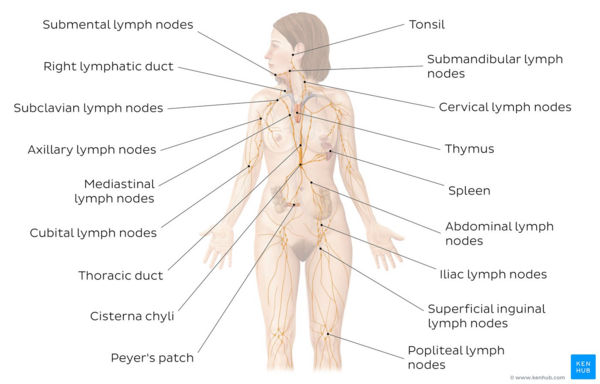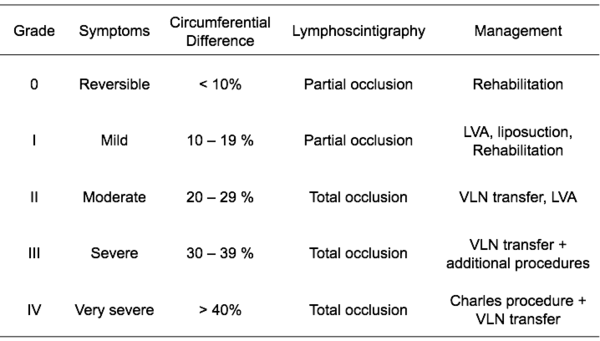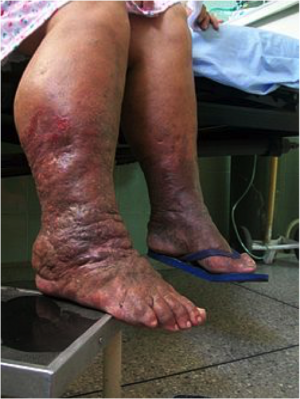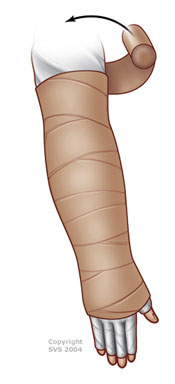Manual Lymphatic Drainage: Difference between revisions
(video reference added and size changed) |
(information updated and citations added) |
||
| Line 43: | Line 43: | ||
'''Different Approaches''' | '''Different Approaches'''<ref name="Williams">Williams A. [https://www.researchgate.net/profile/Anne-Williams-4/publication/44683866_Manual_lymphatic_drainage_Exploring_the_history_and_evidence_base/links/547c94eb0cf2cfe203c1db71/Manual-lymphatic-drainage-Exploring-the-history-and-evidence-base.pdf Manual lymphatic drainage: exploring the history and evidence base]. British Journal of Community Nursing. 2010 Apr;15(Sup3):S18-24.</ref> | ||
* Vodder - Different kinds of hand motions are used on the | * Vodder - Different kinds of hand motions are used on the skin depending on the part of the body being treated. It also includes edema movements at fibrotic areas. The different motions include "pump", "scoop", "stationery circle", "rotary" and "thumb circle". | ||
* Foldi - Based on the Vodder technique, this method lays emphasis on thrust and relaxation. | * Foldi - Based on the Vodder technique, this method lays emphasis on a "thrust" and "relaxation" phase. 'Encircling strokes' are included in this approach. | ||
* Casley-Smith - This method involves use of | * Casley-Smith - This method involves use of gentle and slow effleurage movements with the side of the hand. The effleurage movements are performed over the "watershed" areas between lymphotomes. | ||
* Leduc - It involves use of | * Leduc - It involves use of "call up" (or enticing) and "reabsorption" movements which reflects how lymph is absorbed first in the initial lymphatics and then into larger lymphatics. | ||
== Indications == | == Indications == | ||
[[File:Lymphoedema red leg.png|right|frameless]]MLD is indicated in primary or secondary [[Lymphatic Obstruction (Lymphedema)|lymphedema ]]<nowiki/>in the following situations: | |||
*When there is swelling at a limb's root<ref name="best practice" /> | |||
*When trunk and midline edema is present<ref name="best practice" /> | |||
*When comfort and pain relief is required but other therapies are no longer appropriate - palliative<ref name="best practice" /> | |||
*As an adjunct to pain management<ref name="best practice" /> | |||
*As a preventative treatment<ref name=":0" /> | |||
*Chronic venous insufficiency <ref name="venous ins" /> | |||
MLD may also be helpful in the below situations: | |||
*It may be used as a complement treatment for patients with psychological stress. <ref>Jung-Myo S, Sung-Joong K. Manual Lymph Drainage Attenuates Frontal EEG Asymmetry in Subjects with Psychological Stress: A Preliminary Study. J Phys Ther Sci. 2014 Apr; 26(4): 529–531.</ref><ref>Shim JM, Yeun YR, Kim HY, Kim SJ. [[Effects of manual lymph drainage for abdomen on the brain activity of subjects with pshttps://www.jstage.jst.go.jp/article/jpts/29/3/29 jpts-2016-900/ pdfychological stress|Effects of manual lymph drainage for abdomen on the brain activity of subjects with psychological stress]]. Journal of physical therapy science. 2017;29(3):491-4.</ref> | |||
*It (craniocervical MLD) may be effective for reducing intracranial pressure in people with severe cerebral diseases.<ref>Roth C, Stitz H, Roth C, Ferbert A, Deinsberger W, Pahl R et. al. [https://www.researchgate.net/profile/Holger-Engel/publication/303687614_Craniocervical_manual_lymphatic_drainage_and_its_impact_on_intracranial_pressure_-_a_pilot_study/links/5c66682d45851582c3e98103/Craniocervical-manual-lymphatic-drainage-and-its-impact-on-intracranial-pressure-a-pilot-study.pdf Craniocervical manual lymphatic drainage and its impact on intracranial pressure - a pilot study]. Eur J Neurol. 2016 Sep;23(9):1441-6.</ref> | |||
== Contraindications == | |||
* | '''General contraindications'''<ref name="best practice" />''':''' | ||
* | * Acute cellulitis/erysipelas | ||
* | * Severe cardiac insufficiency | ||
* | * Hepatic cirrhosis with abdominal fluid (ascites) | ||
* | * Unstable hypertension | ||
* Renal failure | |||
* Untreated tuberculosis or malaria | |||
* Superior vena cava obstruction | |||
''' | '''Local contraindications:''' | ||
*Untreated thyroid dysfunction | |||
* | *Metastases | ||
* | *Primary tumours | ||
== Principles == | == Principles == | ||
| Line 98: | Line 100: | ||
== Physiotherapy == | == Physiotherapy == | ||
MLD is often given as part of [[Complete Decongestive Therapy (CDT)|Complete Decongestive Therapy]] (CDT).[[File: | MLD is often given as part of [[Complete Decongestive Therapy (CDT)|Complete Decongestive Therapy]] (CDT). | ||
[[File:Lymphedema_02_Base_175.jpg|alt=|right|frameless]] | |||
* CDT is the most effective treatment for lymphedema, as it reduces the symptoms of lymphedema and improves patients’ functionality, mobility, and quality of life. | * CDT is the most effective treatment for lymphedema, as it reduces the symptoms of lymphedema and improves patients’ functionality, mobility, and quality of life. | ||
* CDT is a combination of four methods (manual lymphatic drainage, lymphedema rehabilitation exercises, compression therapy, skin care). It can achieve a 45-70% reduction in lymphedema volume. | * CDT is a combination of four methods (manual lymphatic drainage, lymphedema rehabilitation exercises, compression therapy, skin care). It can achieve a 45-70% reduction in lymphedema volume. | ||
Revision as of 17:23, 4 January 2023
Description[edit | edit source]
Manual Lymph drainage (MLD), is a technique developed by the Vodders (Dr. Emil Vodder and his wife, Estrid) in 1936 in Paris for treatment of swollen lymph nodes[1].
Lymphatic diseases, especially lymphedema, represent a serious problem in the health community[2].
MLD is a light, skin-stretching massage that helps promote the movement of lymphatic fluid out of the swollen limb. It should not be confused with a traditional massage. MLD is specifically focused on the lymph vessels to help the flow of lymphatic fluid. Therapy is applied to your unaffected areas first, making it possible for the fluid to move out of the affected area, or “decongest” the region. MLD helps open the remaining functioning lymph collectors and move protein and fluid into them, as well as to help speed up lymph fluid flow through the lymphatics.
Deep breathing techniques called diaphragmatic breathing are usually done at the beginning and end of a therapy session to help open the deep lymphatic pathways. It’s not only relaxing, but it helps increase movement of fluid toward the heart[3].
Image: Overview of the lymphatic system[4]
MLD:
- The intention behind MLD is to augment the rhythmic contractions and stimulate the lymph nodes to improve their activity in order to reroute stagnant lymphatic fluid[2].
- MLD is comprised of four main strokes: stationary circles, scoop technique, pump technique, and rotary technique[2].
- It is effective as a preventative and postoperative rehabilitation treatment[2].
- MLD is a a key component Complete Decongestive Therapy (CDT)[5]. It shows optimal results when it is combined with the other CDT elements[2].
- MLD also increases blood flow in deep and superficial veins[6].
- MLD may be useful in conditions such as post-traumatic and post-surgical edema[2] and palliative care[2].
Techniques[edit | edit source]
There are various techniques for MLD including the Vodder, Földi, Leduc or Casley-Smith methods.
MLD is recommended as a component of CDT, but is often used in combination with other treatments[2]. MLD in isolation is effective but a combination of the parts of CDT is optimal[2]. CDT has been shown to be effective in reducing lymphedema volume and improving quality of life patient mobility[2].
It often takes many hours of training in MLD, combined with years of hands-on experience, for a lymphedema therapist to become truly skilled.
The most appropriate techniques, optimal frequency and indications for MLD, as well as the benefits of treatment, all remain to be clarified, but the different methods have several aspects in common, including the following[5] :
- Usually performed with the patient in the lying position
- Starts and ends with deep diaphragmatic breathing
- The unaffected lymph nodes and region of the body are treated first
- Moves proximal to distal to drain the affected areas
- Slow and rhythmical movements
- Uses gentle pressure - this is essential
The video below gives a very brief explanation of Manual Lymphatic Drainage
There are four primary stages of lymphedema that each impact the body in different ways, and can be categorized according to severity. The duration of treatments varies depending on the stage of lymphoedema the client has eg intensive treatment may be for 2-4 weeks and less intensive treatments could last for months or for years .[2]
Different Approaches[8]
- Vodder - Different kinds of hand motions are used on the skin depending on the part of the body being treated. It also includes edema movements at fibrotic areas. The different motions include "pump", "scoop", "stationery circle", "rotary" and "thumb circle".
- Foldi - Based on the Vodder technique, this method lays emphasis on a "thrust" and "relaxation" phase. 'Encircling strokes' are included in this approach.
- Casley-Smith - This method involves use of gentle and slow effleurage movements with the side of the hand. The effleurage movements are performed over the "watershed" areas between lymphotomes.
- Leduc - It involves use of "call up" (or enticing) and "reabsorption" movements which reflects how lymph is absorbed first in the initial lymphatics and then into larger lymphatics.
Indications[edit | edit source]
MLD is indicated in primary or secondary lymphedema in the following situations:
- When there is swelling at a limb's root[5]
- When trunk and midline edema is present[5]
- When comfort and pain relief is required but other therapies are no longer appropriate - palliative[5]
- As an adjunct to pain management[5]
- As a preventative treatment[2]
- Chronic venous insufficiency [6]
MLD may also be helpful in the below situations:
- It may be used as a complement treatment for patients with psychological stress. [9][10]
- It (craniocervical MLD) may be effective for reducing intracranial pressure in people with severe cerebral diseases.[11]
Contraindications[edit | edit source]
General contraindications[5]:
- Acute cellulitis/erysipelas
- Severe cardiac insufficiency
- Hepatic cirrhosis with abdominal fluid (ascites)
- Unstable hypertension
- Renal failure
- Untreated tuberculosis or malaria
- Superior vena cava obstruction
Local contraindications:
- Untreated thyroid dysfunction
- Metastases
- Primary tumours
Principles[edit | edit source]
- The skin is stretched in specific directions using hand movements to promote variations in interstitial pressure without the use of oils.
- Slow repetitive movements are used which incorporate a resting phase allowing skin to return to its normal position.
- The pressure is varied according to the underlying tissue with the aim to promote lymphatic drainage.
- Areas of fibrosis are treated using deeper and firmer movements in combination with Compression therapy.
- The lymphatic drainage starts centrally and proximally with treatments usually starting around the neck.
- Functional and healthy lymph nodes are treated first, followed by proximal and contralateral areas and then ipsilateral and lymphoedematus areas.
- There is emphasis on treatment of anterior and posterior trunk in the early phases before the swollen limb is treated.
- Breathing techniques used are combined with pressure by the therapist's hands which promotes drainage of deep abdominal lymph nodes.
- Limb mobilization and relaxation techniques are often combined with lymphatic drainage.[8]
Physiotherapy[edit | edit source]
MLD is often given as part of Complete Decongestive Therapy (CDT).
- CDT is the most effective treatment for lymphedema, as it reduces the symptoms of lymphedema and improves patients’ functionality, mobility, and quality of life.
- CDT is a combination of four methods (manual lymphatic drainage, lymphedema rehabilitation exercises, compression therapy, skin care). It can achieve a 45-70% reduction in lymphedema volume.
Components of CDT include
- MLD
- Skin care
- Self-massage following instructions from their therapists
- Special light exercises designed to encourage the flow of lymphatic fluid out of the affected limb.
- Wear compression garments such as long sleeves or stockings designed to compress the arm or leg and encourage lymphatic flow out of the limb[12].
Resources[edit | edit source]
- Browse videos on this page regarding techniques on Lymphedema management.
- Manual Lymphatic Drainage (MLD) History
References[edit | edit source]
- ↑ Dr Vodder School International. Manual Lymph Drainage History (MLD). Available from: https://vodderschool.com/manual_lymph_drainage_history (Accessed 3 September 2020)
- ↑ 2.00 2.01 2.02 2.03 2.04 2.05 2.06 2.07 2.08 2.09 2.10 2.11 Tzani I, Tsichlaki M, Zerva E, Papathanasiou G, Dimakakos E. Physiotherapeutic rehabilitation of lymphedema: State-of-the-art. Lymphology. 2018 Jul 2;51(1):1-2.
- ↑ Lymph care MLD Available from:https://www.lymphcareusa.com/patient/therapy-solutions/complete-decongestive-therapy/manual-lymphatic-drainage-mld.html (last accessed 17.8.2020)
- ↑ Overview of the lymphatic system image - © Kenhub https://www.kenhub.com/en/study/lymphatic-system
- ↑ 5.0 5.1 5.2 5.3 5.4 5.5 5.6 Lymphoedema Framework. Best Practice for the Management of Lymphoedema. International consensus. London: MEP Ltd, 2006.
- ↑ 6.0 6.1 Crisóstomo RS, Candeias MS, Armada-da-Silva PA. Venous flow during manual lymphatic drainage applied to different regions of the lower extremity in people with and without chronic venous insufficiency: a cross-sectional study.Physiotherapy. 2016 Feb 1. pii: S0031-9406(16)00023-7.
- ↑ National Lymphedema Network. Manual Lymph Drainage (MLD). Available from: http://www.youtube.com/watch?v=dT6rAL4-D14[last accessed 01/04/2022]
- ↑ 8.0 8.1 Williams A. Manual lymphatic drainage: exploring the history and evidence base. British Journal of Community Nursing. 2010 Apr;15(Sup3):S18-24.
- ↑ Jung-Myo S, Sung-Joong K. Manual Lymph Drainage Attenuates Frontal EEG Asymmetry in Subjects with Psychological Stress: A Preliminary Study. J Phys Ther Sci. 2014 Apr; 26(4): 529–531.
- ↑ Shim JM, Yeun YR, Kim HY, Kim SJ. Effects of manual lymph drainage for abdomen on the brain activity of subjects with psychological stress. Journal of physical therapy science. 2017;29(3):491-4.
- ↑ Roth C, Stitz H, Roth C, Ferbert A, Deinsberger W, Pahl R et. al. Craniocervical manual lymphatic drainage and its impact on intracranial pressure - a pilot study. Eur J Neurol. 2016 Sep;23(9):1441-6.
- ↑ WEIL MLD Available from:https://www.drweil.com/health-wellness/balanced-living/wellness-therapies/lymphatic-massage-therapy/ (last accessed 28.7.2020)










